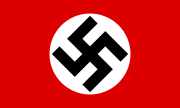
Back Nasionaal-Sosialistiese Duitse Arbeidersparty Afrikaans Nationalsozialistische Deutsche Arbeiterpartei ALS الحزب النازي Arabic الحزب النازى ARZ Partíu Nacionalsocialista Obreru Alemán AST Nasional Sosialist Alman Fəhlə Partiyası Azerbaijani NSDAP BAR Нацыянал-сацыялістычная нямецкая рабочая партыя Byelorussian Нацыянал-сацыялістычная нямецкая працоўная партыя BE-X-OLD Националсоциалистическа германска работническа партия Bulgarian
National Socialist German Workers' Party Nationalsozialistische Deutsche Arbeiterpartei | |
|---|---|
 | |
| Leader | Anton Drexler (1920–1921) Adolf Hitler (1921–1945) Martin Bormann (1945) |
| Founder | Anton Drexler |
| Founded | 1920 |
| Dissolved | 1945 |
| Preceded by | German Workers' Party (DAP) |
| Succeeded by | None (banned) Ideologies continued with neo-Nazism |
| Headquarters | Munich, Germany[1] |
| Newspaper | Völkischer Beobachter |
| Youth wing | Hitler Youth |
| Paramilitary wing | Sturmabteilung (SA) Schutzstaffel (SS) Motor Corps (NSKK) Flyers Corps (NSFK) |
| Membership | Fewer than 60 in 1920 8.5 million by 1945 |
| Ideology | Nazism |
| Political position | Far-right[2][3] |
| International affiliation | None |
| Colors | Black, white, red (Imperial Germany's colors); brown |
| Anthem | "Horst-Wessel-Lied" |
| Party flag | |
 | |
The National Socialist German Workers' Party (German ; Nationalsozialistische Deutsche Arbeiterpartei, abbreviated NSDAP), also known as the Nazi Party, was a far-right[4][5][6] German political party. It was started in 1920 from the German Workers' Party (German: Deutsche Arbeiterpartei, DAP),[7] which would later be renamed the NSDAP. On the day it was created, the party published its 25-point manifesto (book of ideas). The items in this list of ideas included getting rid of the Treaty of Versailles; gaining more land for the German people; taking away any income people had not earned by working; taking away Jewish people's citizenship; changing the education system; and setting up a strong central government.[7] It is most known for being Hitler's political party.
From 1920 until 1923, Hitler the NSDAP became to most popular in Bavaria since the Beer Hall Putsch of 1923 . In June 1934 the Nazi Party started Night of the Long Knives to kill SA leader Ernst Röhm and German Chancellor Kurt von Schleicher .
- ↑ Rick Steves. Rick Steves' Snapshot Munich, Bavaria & Salzburg. Berkeley, California, USA; New York, New York, USA: Avalon Travel, 2010. p. 28. "Though the Nazis eventually gained power in Berlin, they remembered their roots, dubbing Munich "Capital of the Movement". The Nazi headquarters stood near today's obelisk on Brienner Strasse..."
- ↑ Davidson, Eugene (1997). The Making of Adolf Hitler: The Birth and Rise of Nazism. University of Missouri Press. p. 241. ISBN 9780826211170.
- ↑ Orlow, Dietrich (23 June 2010). The Nazi Party 1919-1945: A Complete History. Enigma Books. p. 29. ISBN 9780982491195.
- ↑ Fritzsche 1998, p. 143,185,193,204-205,210.
- ↑ Eatwell, Roger (1997). Fascism : a history. New York: Penguin Books. pp. xvii–xxiv, 21, 26–31, 114–40, 352. ISBN 0-14-025700-4. OCLC 37930848.
- ↑ "The Nazi Party". United States Holocaust Memorial Museum. Retrieved 2022-10-20.
- ↑ 7.0 7.1 "The History Place - Rise of Hitler: Nazi Party is Formed". historyplace.com. Retrieved 29 December 2010.